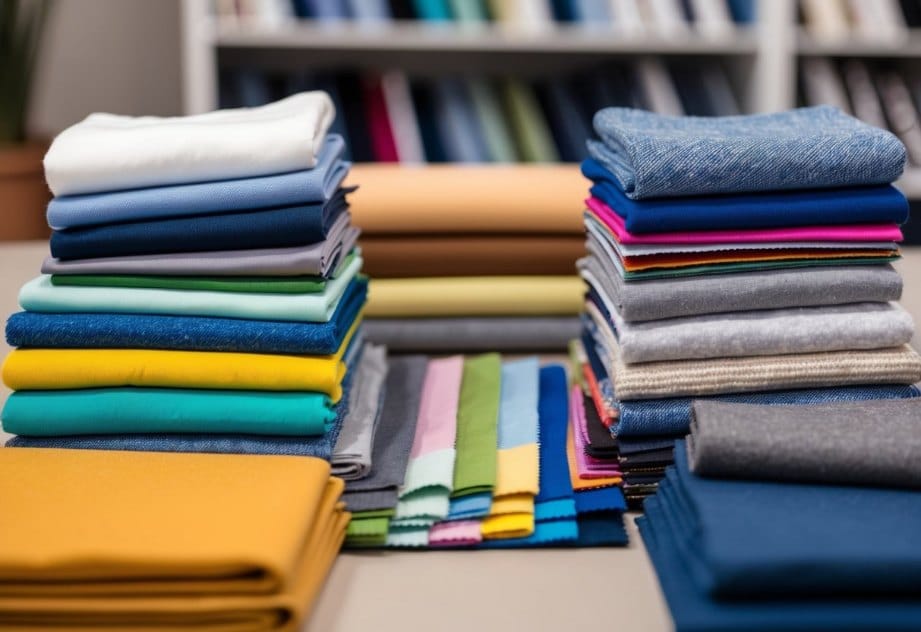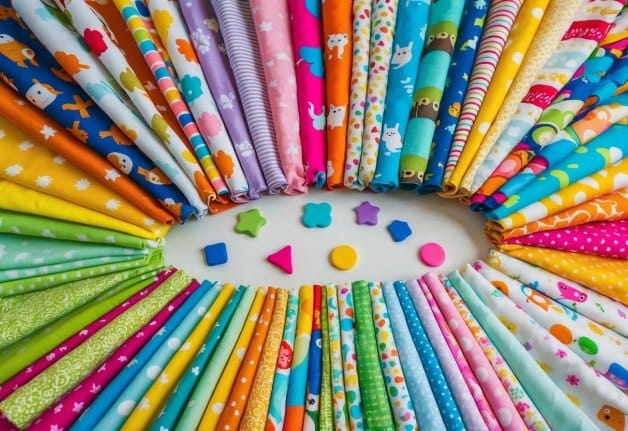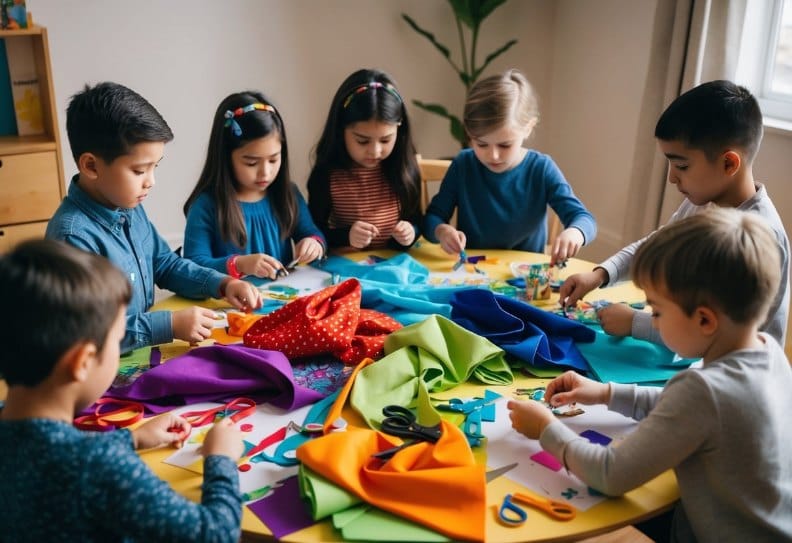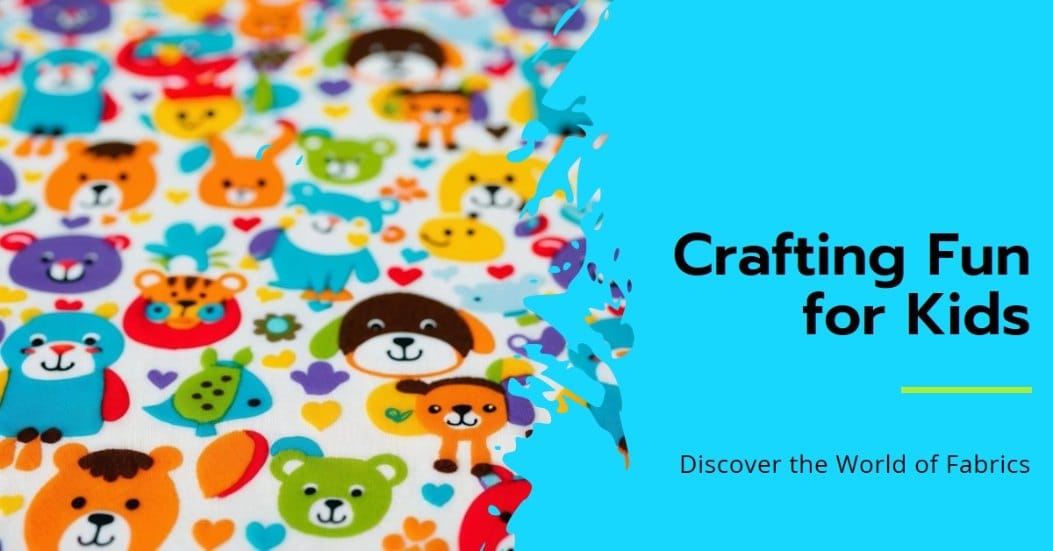Children’s fabric opens up a world of creativity for making charming clothes, bedding, and toys. From playful prints to cosy textures, these materials bring joy to little ones and their caretakers alike. Choosing the right fabric for children’s projects involves considering durability, comfort, and age-appropriate designs.
Fabrics Galore London and other speciality shops offer a wide range of options for children’s textiles. You’ll find everything from soft cotton for baby clothes to sturdy denim for playwear. Popular choices include colourful quilting cottons with fun patterns, stretchy jerseys for comfy pyjamas, and waterproof fabrics for outdoor gear.
When shopping for children’s fabric, keep in mind the intended use and care requirements. Look for washable materials that can stand up to frequent cleaning. Safety is also key – avoid fabrics with small parts that could come loose and pose a choking hazard for young children.
On This Page
Key Takeaways
- Children’s fabric comes in various types suited for different projects and ages
- Durability, comfort, and safety are important factors when choosing fabrics for kids
- Speciality shops offer a wide selection of children’s textiles for clothing and crafts
Understanding Fabric Types

Fabric choices play a crucial role in children’s clothing. Different materials offer unique qualities that affect comfort, durability, and style. Let’s explore some key fabric types used in kids’ garments.
Cotton and its Varieties
Cotton stands out as a top pick for children’s clothes. It’s soft, breathable, and gentle on sensitive skin. Pure cotton absorbs sweat well, keeping kids cool in warm weather.
Poplin cotton has a crisp feel and works great for shirts and dresses. It’s lightweight and smooth.
Flannel cotton is fuzzy and warm. It’s perfect for cosy pyjamas and winter shirts.
Corduroy cotton has raised ridges. It’s sturdy and good for trousers and jackets.
Explore Jersey and Knits
Jersey is a stretchy knit fabric. It’s comfy and moves with active kids.
T-shirts often use jersey cotton. It’s soft and drapey.
Interlock knit is thicker than jersey. It has a smooth surface on both sides.
Rib knit has raised lines. It’s stretchy and snug-fitting.
Fleece is a brushed knit. It’s warm and fluffy, great for jumpers and jackets.
Linen, Viscose, and Chambray
Linen is a light, airy fabric. It’s cool in hot weather but wrinkles easily.
Viscose feels silky and drapes well. It’s absorbent and good for summer clothes.
Chambray looks like denim but is lighter. It’s soft and breathable, ideal for shirts and dresses.
These fabrics blend well with cotton. This mix can improve durability and reduce wrinkles.
Luxurious Wool textiles
Wool keeps kids warm in cold weather. It’s naturally water-resistant and breathable.
Merino wool is extra soft. It’s not itchy, making it nice for sensitive skin.
Cashmere is very soft and light. It’s warm but pricey.
Wool blends mix wool with other fibres. This can make clothes easier to care for and less costly.
Fabrics for Children’s Projects

Selecting the right fabrics for children’s projects is key to creating fun, comfortable, and durable items. The best choices are soft, easy to work with, and stand up to active play and frequent washing.
Choosing Fabrics for Dressmaking
Cotton is a top pick for children’s clothing. It’s breathable, soft, and easy to care for. Look for lightweight cottons like poplin or lawn for summer dresses. For cooler weather, try cotton flannel or corduroy.
Jersey knit is great for comfy t-shirts and leggings. It stretches and moves with active kids. Choose a cotton-spandex blend for extra elasticity.
For special occasions, consider cotton sateen or velvet. These fabrics add a touch of luxury while still being kid-friendly.
Always pre-wash fabrics before sewing to prevent shrinkage later. This step is extra important for children’s clothes that will be washed often.
Patchwork and Quilting
Quilting cotton is perfect for patchwork and quilts. It’s sturdy, holds its shape well, and comes in countless prints and colours.
Fat quarters are handy for small projects. These pre-cut pieces measure about 50 cm x 55 cm and are great for trying out new patterns.
For quilt backing, use wide cotton fabric. It’s available in 2.7-metre widths, reducing the need for seams.
Batting, the middle layer of a quilt, comes in various thicknesses. Cotton batting is warm and gets softer with washing. Polyester batting is lighter and keeps its shape well.
Remember to press seams as you go for neat, flat quilts.
Liberty Cotton Lawn Prints
Liberty prints are beloved for children’s projects. These fine cotton lawns feature intricate floral designs and vibrant colours.
The fabric is lightweight and silky-smooth, perfect for summer dresses and blouses. It’s also great for adding special touches to quilts and crafts.
Liberty Tana Lawn is especially prized. It’s made from long-staple cotton fibres, resulting in a crisp yet soft feel.
While pricier than standard cottons, Liberty fabrics are durable and often become family heirlooms. They’re ideal for special occasion outfits or memory quilts.
Try mixing Liberty prints with solid colours for a balanced look in patchwork projects.
Buying Guide for Children’s Fabrics

When shopping for children’s fabrics, you have several options to explore. From local shops to online stores and designer collections, each offers unique advantages for finding the perfect fabric for your little ones.
High-Street Fabric Shops
High-street fabric shops provide a hands-on experience for selecting children’s fabrics. You can feel the textures and see the colours up close. Many shops offer a range of options, from basic cottons to speciality prints.
These shops often have knowledgeable staff who can offer advice on fabric care and suitability for different projects. Some may even stock designer fabrics at competitive prices.
Look for shops that carry child-friendly themes and patterns. They might have sections dedicated to nursery fabrics or school uniform materials.
Online Fabric Offerings
Online stores have revolutionised fabric shopping for children’s wear. They offer a vast selection of fabrics from around the world, often at lower prices than brick-and-mortar shops.
Many online retailers provide detailed product descriptions, high-quality images, and customer reviews. This information can help you make informed decisions about fabric quality and suitability.
Popular online fabric shops often stock exclusive prints and licensed character fabrics that children love. They may also offer sample services, allowing you to check the fabric before buying larger amounts.
Designer Fabric Collections
Designer fabrics add a touch of luxury to children’s clothing and decor. Brands like Cath Kidston, Orla Kiely, and Laura Ashley offer beautiful fabrics with distinctive patterns and high-quality materials.
These collections often feature playful prints and timeless designs that appeal to both children and adults. Designer fabrics can be pricier, but they often boast superior durability and unique aesthetics.
Look for collaborations between designers and fabric manufacturers. These partnerships can result in exciting, limited-edition prints perfect for special occasions or statement pieces in a child’s room.
Creative Applications and Projects

Children’s fabrics open up a world of fun and imaginative possibilities. From crafting to decorating, these versatile materials can be used in many ways to spark creativity and make special items for young ones.
Crafting with Children
Fabric crafts are perfect for little hands. Simple no-sew projects like sock puppets or fabric collages let kids explore textures and colours. Cut fabric scraps into shapes for mosaic-style pictures. Fabric paint adds flair to plain t-shirts or tote bags.
For slightly older children, try making fabric bookmarks or simple stuffed toys. Use safety scissors to cut felt into animal shapes. Glue on googly eyes and decorations. Older kids can learn basic hand-sewing to make pouches or pillows.
Fabric tape is great for quick crafts. Kids can wrap it around cardboard tubes to make colourful pencil holders. Or use it to decorate picture frames for a personal touch.
Home Furnishing for Young Ones
Brighten up a child’s room with homemade fabric décor. No-sew curtains are an easy project – just hem fabric with iron-on tape. Make coordinating cushion covers to match.
For a fun touch, create a fabric growth chart. Paint or embroider numbers on a long strip of sturdy fabric. Hang it on the wall to track your child’s height.
Fabric bunting adds a festive feel. Cut triangles from cheerful prints and string them together. Drape across windows or along bookshelves. For babies, sew a simple cot mobile using fabric scraps and stuffing.
Sewing Projects for Beginners
Basic sewing skills open up even more creative options. Start with straight-stitch projects like pillowcases or drawstring bags. These teach measuring, cutting and sewing in straight lines.
Simple clothing items are great next steps. Try making elastic-waist shorts or skirts. Add pockets for extra practice. Aprons are another practical project that kids will enjoy using.
For a cuddly friend, sew a simple stuffed animal. Use a basic shape like a fish or teddy bear. Let kids pick their favourite fabric and add details like button eyes or a felt mouth.
Promoting Your Creations
Showcasing children’s fabric creations can open doors to recognition and future opportunities. Social media platforms and collaborations offer effective ways to share these artistic works with a wider audience.
Leveraging Social Media
Social media is a powerful tool for displaying children’s fabric art. Platforms like Instagram and Pinterest are ideal for sharing colourful photos of handmade items. Parents can create dedicated accounts to document their child’s creative journey. Regular posts with relevant hashtags can help build a following. Facebook groups for crafting and sewing are great for connecting with other fabric enthusiasts. Sharing tips and progress photos can spark interest and engagement. It’s important to respect privacy and only post content the child is comfortable sharing.
Collaborations with Designers
Partnering with established designers can boost visibility for children’s fabric creations. Local craft fairs and markets are good places to network and find potential collaborators. Some designers may be interested in featuring children’s work in their collections. This can lead to exciting projects like creating prints for the home furnishing section of shops. Children might even draw inspiration from famous textile designers like William Morris. Collaborative workshops where kids learn new techniques can be a fun way to expand skills and make connections. These partnerships can provide valuable exposure and learning experiences for young fabric artists.
Frequently Asked Questions
What is the most common fabric used in children’s wear?
The most common fabric for children’s wear is cotton. It is highly breathable, soft, and comfortable, making it ideal for sensitive skin.
Cotton is also durable and easy to clean, which is essential for kids’ clothing. Additionally, cotton blends, like cotton with a bit of elastane, are also popular for offering some stretch without sacrificing comfort.
What are the properties of fabric for kids?
Fabrics for children’s wear should have the following properties:
• Breathability: Allows air to flow freely, keeping kids comfortable and preventing overheating.
• Softness: Gentle on sensitive skin, especially important for babies and toddlers.
• Durability: Able to withstand rough play and frequent washing.
• Hypoallergenic: Minimises irritation or allergic reactions.
• Absorbency: Particularly important for infants to absorb moisture and avoid rashes.
What are the points to consider in choosing fabric for children’s wear?
When choosing fabric for children’s wear, consider:
• Comfort: Soft, breathable fabrics like cotton or bamboo are best for comfort.
• Safety: Avoid fabrics treated with harsh chemicals or dyes, as they can irritate sensitive skin.
• Durability: Children are active, so fabrics need to withstand regular wear and tear.
• Ease of care: Choose fabrics that are easy to clean and maintain, like machine-washable cotton.
How much fabric do I need for a kids’ dress?
For a simple children’s dress, the amount of fabric needed typically ranges from 1 to 1.5 metres depending on the size and style of the dress.
For toddlers or younger children, you might need around 1 metre, while larger sizes or more intricate designs could require 1.5 metres or more.
What fabric is commonly used by beginners?
Beginners usually start with cotton fabric. It’s easy to handle, doesn’t slip or stretch excessively, and is available in a wide variety of colours and patterns.
Cotton is forgiving for sewing mistakes, making it ideal for new crafters.
Is 100% cotton good for kids?
Yes, 100% cotton is one of the best fabrics for kids. It’s breathable, soft, and hypoallergenic, making it a top choice for children’s clothes, especially for infants and toddlers.
It also absorbs moisture, helping to keep skin dry and reducing the risk of irritation or rashes.
Which fabric is an appropriate choice for children’s playwear?
For children’s playwear, cotton jersey or a cotton-spandex blend is a great choice.
These fabrics are soft, stretchy, and comfortable, allowing for plenty of movement.
They are also durable and breathable, making them perfect for active kids.
What is the best fabric for messy kids?
For messy kids, polyester-cotton blends are a good choice as they are more stain-resistant and easier to clean than pure cotton.
Denim or twill fabrics can also work well for messy environments, especially for trousers and outerwear.
What fabric is best for children’s pajamas?
The best fabric for children’s pajamas is cotton or cotton flannel for cooler climates. Both are breathable, soft, and gentle on the skin.
For warmer weather, bamboo fabric is another excellent choice due to its lightweight, moisture-wicking properties.
What are three criteria you would feel are important when choosing fabrics for a children’s wear line?
When choosing fabrics for a children’s wear line, the three most important criteria are:
1. Safety and comfort: The fabric must be non-toxic, hypoallergenic, and soft on delicate skin.
2. Durability: Kids’ clothes should be able to withstand constant washing and rough play without losing shape or colour.
3. Functionality: The fabric should be easy to clean, breathable, and appropriate for the specific purpose (e.g., warmer fabrics for winter, lighter fabrics for summer).

